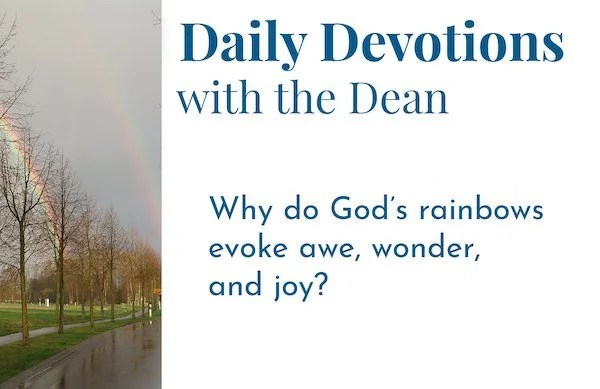Tuesday • 1/16/2024 •
Tuesday of 2 Epiphany, Year Two
This morning’s Scriptures are: Psalm 26; Psalm 28; Genesis 9:1–17; Hebrews 5:7–14; John 3:16–21
This morning’s Canticles are: following the OT reading, Canticle 13 (“A Song of Praise,” BCP, p. 90); following the Epistle reading, Canticle 18 (“A Song to the Lamb,” Revelation 4:11; 5:9–10, 13, BCP, p. 93)
Welcome to Daily Office Devotions, where every Monday through Friday we draw insights from that day’s Scripture readings, as given in the Book of Common Prayer. I’m Reggie Kidd, and I’m grateful to be with you this Tuesday in the Second Week of Epiphany. Our readings come from Year 2 in the Daily Office Lectionary.
Genesis 9: “Double rainbow!” Sometimes when I get a bit down, I go to YouTube and pull up Yosemitebear’s video: “Double rainbow! What does it meeeeeean?” It makes me smile every time.
God’s beautiful rainbows, what, indeed do they mean? Why do they evoke awe, wonder, and joy?
With the entrance of evil into the world, life on earth devolves into chaos. Adam and Eve listen to the serpent’s hiss. Cain kills Abel, and Genesis 4 through the first part of Genesis 6 depicts an unrelenting slide into violence and degradation.
The Bible’s message, however, is that God is not content to let chaos win. He intervenes, to borrow a phrase from the writer to the Hebrews, “at many times and in various ways,” to reverse the tendency to pandemonium.
The flood account in Genesis 6–9 is the Bible’s way of saying that after the inexorable, irresistible slide into darkness that ensues with Adam and Eve’s cosmic treason, God begins to make a new start, with a new humanity. A new humanity rescued from destruction by their association with the one righteous man, Noah (Genesis 6:9). A new humanity consisting of eight family members simply willing to get on the ark with him.
When the flood subsides, God establishes with them (and through them with the whole earth) a covenant (Genesis 9:9). Their part in that covenant is a reprise of the instructions God originally gave to Adam and Eve: fill the earth, tend it, care for it, draw out its potential for order and life — this time, with the momentous responsibility of acting against evil instead of just watching things go from bad to worse (Genesis 9:1–7).
God’s part in this covenant is to place his bow in the sky (the Hebrew term for “rainbow” is the word for “bow and arrow”). Instead of having the “bow” pointed downward, aimed at us in judgment, with arrow notched, God points his “bow” upwards, no arrow, in peace. A sign that God is establishing peace and reconciliation between himself and the errant humanity he loves, among humans themselves, and between us and the animal kingdom we are called to steward.
“Double rainbow! Awesome!!! What does it mean??!!” Here’s what it means: as part of God’s new creation, we take God’s side in resisting the rule of sin and death and decay. As long as there are rainbows in the sky, there’s work for you and me to do, from firefighters rescuing kittens, to teachers turning back illiteracy, to students sorting out their place in this world, to anybody in law trying to make things right (or at least a little less wrong).
Whatever you are called to do to make this world a better place, you are commissioned by God’s covenant with Noah.
John 3: God so loved… For each covenant God establishes with us he provides a “sign,” a visible, tangible promise from him and reminder to us that his relationship with us is real. Each “sign” carries with it a sacramental power, that is, it acts as something like a portal that brings God’s world of promise and provision and our world of desperate need together.
To Noah God provides a rainbow, to Abraham circumcision, to Moses the Sabbath, to David, well, David himself—and in the New Covenant, God provides his own Son as the visible, tangible connection point between himself and us. “God so loved the world that he gave his only begotten Son that whosoever believes in him should not perish but have everlasting life” (John 3:16). God gives the Son who is himself the sign, seal, and sacrament of his commitment to us and of our corresponding obligation to him. Jesus is Bread from Heaven, and True Vine and Cup of Salvation (see John 6 and 15).
Hebrews 5: “with loud cries and tears.” “In the days of his flesh, Jesus offered up prayers and supplications, with loud cries and tears, to the one who was able to save him out of death (Greek ek thanatou), and he was heard because of his reverent submission. Although he was a Son, he learned obedience through what he suffered; and having been made perfect, he became the source of eternal salvation for all who obey him…” (Hebrews 5:7–9a, my rendering). What it takes for Jesus to bring God’s world and ours together, to restore communion between heaven and earth, is for him to walk a hard path.
It’s a path of “learning obedience,” not (like us) from disobedience to obedience, but from one level of obedience to another as he undergoes the entire gamut of human experiences: from potty-training through adolescent desire to adult assumption of calling — all just like us, “yet without sin” (Hebrews 4:15). It’s a path that has him praying as a human. Unlike any other human, however, he does so throughout his life with cries and tears and groans for the tragedy of others’ lives distorted and devastated and destroyed by the power of sin. All the while he also anticipates shouldering all of it on the Cross that lies before him from Day One of the Incarnation; and so, he prays to be delivered “out of death” for us. Today’s passage opens a precious window onto its cost to him, making his walk all the more treasurable to us.
Be blessed this day,
Reggie Kidd+



